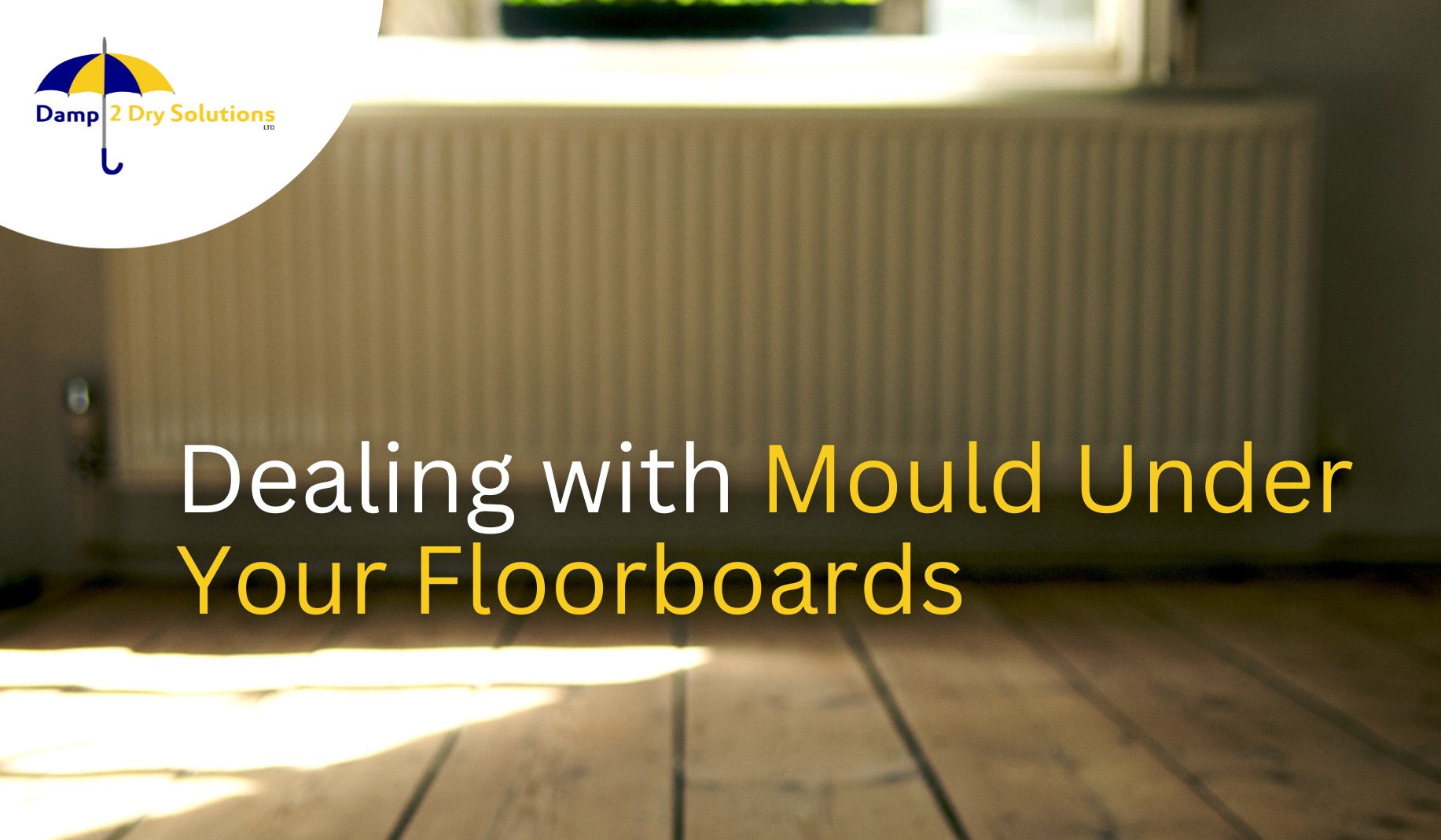
Mould is a fungal growth that flourishes in wet and dark places. It can cause various health problems, such as allergies, asthma, and infections. Mould is a common issue in the UK, especially in older houses that have wooden floorboards. If you suspect that you have mould under your floorboards, you need to act quickly and effectively to prevent further damage and risks.
In this blog, we will cover how to identify, treat, and prevent mould under your floorboards. Let’s start with the types and signs first.
What Kind of Mould Infected the Floor?
To identify the kind of mould that infected your floor, you need to look at its colour, texture, and smell. Some common types of mould that can be found on floors are:
Stachybotrys chartarum
This is also known as toxic black mould, and it has a dark greenish-black colour and a slimy appearance. It can produce mycotoxins that can cause respiratory problems, headaches, and fatigue.
Trichoderma
This is a green or white mould that has a woolly or cottony texture. It can grow on wood, carpet, and wallpaper, and it can cause allergic reactions and damage the structure of your floor.
Penicillium
This is a blue or green mould that has a powdery or velvety texture. It can grow on various materials, such as wood, insulation, and fabrics, and it can cause asthma, sinus infections, and lung inflammation.
Mould Under Floor-Boards: What to Look For
How can you tell if you have mould under your floorboards? Here are some signs to look out for:
Damp patches: If you notice wet or damp spots on your floor, carpet, or skirting boards, it could indicate a moisture problem under your floor. Moisture can come from leaks, spills, or condensation.
Musty smell: Mould has a distinctive and unpleasant odour that can linger in the air. If you smell something musty or earthy in your room, it could be a sign of mould under your floor.
Discolouration and rotting wood: Mould can cause wood to change colour, usually to black, brown, or green. It can also make wood soft and crumbly, which can lead to structural damage and safety hazards.
Common causes: The main causes of mould under floors are condensation, leaks, poor ventilation, and a lack of insulation. These factors create favourable conditions for mould to grow and spread.
What Causes Mould to Grow Under Your Floorboards
To effectively deal with mould under your floorboards, you need to understand what causes it and how to prevent it. Here are some common causes and solutions:
Condensation: Condensation occurs when warm and moist air meets a cold surface, such as a floor or a window. It can cause water droplets to form and accumulate under your floorboards, creating a damp environment for mould. To prevent condensation, you need to maintain optimal humidity levels in your home, which should be between 40% and 60%. You can use a dehumidifier, a humidistat, or a hygrometer to measure and control the moisture in the air.
Leaks: Leaks can come from pipes, appliances, roofs, or walls. They can cause water to seep under your floorboards, causing mould and rot.
To prevent leaks, you need to regularly inspect and repair any sources of water in your home. You can also use waterproof sealants, membranes, or coatings to protect your floor from water damage.
Poor ventilation: Ventilation is the process of exchanging indoor and outdoor air. It helps to remove excess moisture, odours, and pollutants from your home. Poor ventilation can cause stale and humid air to build up under your floorboards, encouraging mould growth.
To improve ventilation, you need to ensure that there is adequate airflow in your home, especially in enclosed spaces such as bathrooms, kitchens, and basements. You can use fans, vents, windows, or extractor fans to increase the circulation of fresh air.
Lack of insulation: Insulation is the material that reduces the transfer of heat between different surfaces. It helps to keep your home warm in winter and cool in summer. Lack of insulation can cause your floor to lose heat and become cold, which can lead to condensation and mould.
To improve insulation, you need to install suitable materials under your floorboards, such as fibreglass, wool, or foam. You can also use rugs, carpets, or mats to cover your floor and reduce heat loss.
How to Banish Mould Under Your Floors for Good

If you have spotted signs of mould under your floors, don’t panic – there is a way to get rid of it and keep it away. Just follow these simple steps to banish mould under your floorboards:
Using a scraper: The first step is to scrape off as much mould as possible from the affected areas. You can use a metal or plastic scraper, a knife, or a spatula to do this.
Be careful not to damage your floor or injure yourself. Wear protective gloves, mask, and goggles to avoid contact with mould spores and dust.
Vacuuming: The next step is to vacuum the area thoroughly to remove any remaining spores and debris. You can use a vacuum cleaner with a HEPA filter, which can capture 99.97% of particles as small as 0.3 microns.
Dispose of the vacuum bag or empty the container outside your home.
Sandpaper: The third step is to sand the area lightly to smooth out any rough or uneven surfaces. You can use a fine-grit sandpaper or a sander to do this.
Be gentle and avoid removing too much wood. Wipe the area with a damp cloth to remove any dust.
Anti-fungal treatment: The fourth step is to apply an anti-fungal treatment to the area to kill any remaining mould and prevent it from regrowing.
You can use a commercial product, such as a spray, a paint, or a varnish, that contains fungicide or bleach. Follow the instructions on the label and let the product dry completely.
Addressing moisture sources: The fifth step is to address the underlying causes of moisture under your floorboards, such as condensation, leaks, poor ventilation, or lack of insulation.
Fix any problems that you find and implement the solutions mentioned above to prevent future mould issues.
Improving air circulation: The sixth step is to improve the air circulation under your floorboards to keep the area dry and fresh. You can use vents, fans, or gaps to create a cross-flow of air that can remove excess moisture and odours. You can also raise your floor slightly to create more space for air movement.
Seeking professional help: The final step is to seek professional help if you have extensive or persistent mould problems under your floorboards.
You can hire a qualified and experienced contractor, such as Damp2Dry Solutions, to inspect, assess, and treat your mould issues. They can provide you with expert advice, quality workmanship, and guaranteed results.
By following the above steps, if you have a question like “Is Mould Removal Difficult To Do?”, the answer is: it depends. Mould removal can be difficult or easy depending on the type, extent, and location of the mould. Some moulds are more resistant to cleaning, some are hidden inside the walls or furniture, and some require special equipment or professional help.
Future Prevention Tips for Mould Under Your Floorboards
The best way to deal with mould under your floorboards is to prevent it from happening in the first place. Here are some smart ways to do that
Check your floorboards often: The first step is to keep an eye on your floorboards for any signs of trouble. You don’t want to find out too late that you have a mould problem. Use a flashlight, a screwdriver, or a moisture meter to inspect your floor for any mould, dampness, or damage.
Do this at least once a year, or more frequently if you live in a humid or rainy climate.
Keep the humidity under control: The second step is to keep the humidity in your home at a comfortable level, between 40% and 60%. Too much moisture in the air can encourage mould growth. You can use a dehumidifier, a humidistat, or a hygrometer to monitor and adjust the humidity in your home.
You should also avoid creating extra moisture, such as by cooking, showering, or drying clothes indoors, without enough ventilation.
Ventilate your home well: The third step is to make sure your home has good airflow, especially in closed spaces like bathrooms, kitchens, and basements. You can use fans, vents, windows, or extractor fans to bring in fresh air and remove stale air.
You should also make sure your floor vents or gaps are not blocked or covered, as they help air circulate under your floorboards.
Insulate your floorboards well: The fourth step is to improve the insulation under your floorboards, as it can help prevent heat loss and condensation. You can use materials like fibreglass, wool, or foam to insulate your floorboards. You can also use rugs, carpets, or mats to cover your floor and keep it warm.
Choose mould-resistant flooring materials: The fifth step is to pick flooring materials that are not likely to get mouldy, such as vinyl, laminate, or tile. These materials are easy to clean and do not soak up moisture.
You should avoid using materials that are susceptible to mould, such as wood, carpet, or cork. If you do use these materials, you should seal them properly and clean them regularly.

To sum up
Mould under your floorboards is a serious issue that can affect your health and safety, as well as the value and appearance of your home. You need to be aware of the signs, causes, and solutions of mould under your floorboards, and act promptly and effectively to deal with it. You also need to take preventive measures to avoid future mould problems.
If you have any questions or feedback about this topic, please feel free to leave a comment below. We would love to hear from you and help you with your mould issues.
If you need professional help with your mould problems, contact Damp2Dry Solutions, a leading damp proofing and mould removal company in the UK.
Damp2Dry Solutions help you with an independent mould survey, a competitive quote, and a high-quality service. You can visit the website, call Damp2Dry Solutions Ltd, or email them on Contact@damp2drysolutions.com to book your appointment today.
Don’t let mould ruin your home and your health. Get in touch with Damp2Dry Solutions and get rid of mould under your floorboards for good.
